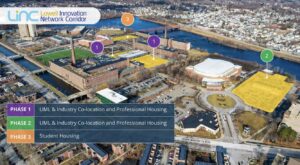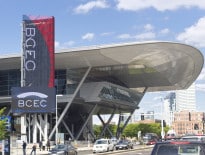
An artist's rendering of the Lowell Innovation Network Corridor project planned for UMass Lowell, which will add hundreds of thousands of square feet of mixed-use development, hundreds of new housing units and a dormitory. Image courtesy of UMass Lowell
Big plans are in motion at UMass Lowell.
The university will embark on a massive, nearly $800 million development campaign poised to bring hundreds of units of housing, hundreds of thousands of square feet of commercial space and a new dormitory to the Mill City.
Taken together, officials view the Lowell Innovation Network Corridor project – which will be financed mostly by private developers – as one of the most substantial changes coming to the city in decades. The project is expected to generate over $3.7 billion in economic activity and create 2,000 permanent jobs over the next decade along with “several million dollars” in new property tax revenue for Lowell, the Healey administration said in an announcement Thursday morning.
“This is the most important economic development in Lowell in more than 20 years,” UMass President Marty Meehan, a longtime Lowellian, told the News Service. “This will be the most significant commercial development on the banks of the Merrimack River since the mills.”
Campus officials have been rolling out highlights of the plans in recent days, and Gov. Maura Healey traveled to Lowell on Thursday for an event with Meehan, UMass Lowell Chancellor Julie Chen and other officials to announce the project’s anchor tenant.
Draper Labs Will Anchor Buildings
The project will unfold in three major phases. The first two phases will happen roughly simultaneously, each adding mixed-use space. One will build out land next to the Tsongas Arena, and a counterpart will rise a stone’s throw away near the Wannalancit Mills.
Chen said both locations will each add a roughly 300,000 square foot building, about 20 percent of which UMass Lowell will occupy. Companies who want to be close to campus will lease remaining space.
“We’re excited about that because that means those are prime companies to hire our students as paid interns as well as to hire them after they graduate,” she said in an interview.
In an announcement Thursday morning, the Healey administration said one of those companies will be Draper Laboratories, who will move its microelectronics research division there. Healey’s office described Draper as the “anchor tenant” but did not say how much space the company would be taking.
“Universities are engines of innovation, with powerful ideas that the world needs, but making those ideas real is no small task. Draper is here to help with mentorships, prototype testing and development and opportunities for customer collaborations that result in fielded and deployed solutions,” Draper President and CEO Jerry M. Wohletz said in a statement provided by Healey’s office.
More than half of the 17,000-plus students at UMass Lowell are studying STEM fields, Chen said.
500 New Homes to Keep Talent in Town
For both new mixed-use spaces, developers will build housing next door, geared toward recent graduates and young professionals. That development will add nearly 500 total units of housing to Lowell’s stock.
Chen estimated groundbreaking will begin next year, followed by about two years of construction and then occupancy in 2027.
The project’s third phase, which does not have a clear timeline, envisions a new 461-bed dormitory near LeLacheur Park.
UMass Lowell is working with private developers GMH Communities and Wexford on the project. Chen said the school, city and state will collectively shoulder about 20 percent of the project cost, and the developers will cover the other 80 percent.
More than a dozen other colleges and universities across the country have embarked on similar efforts with the developers, according to Chen, who said Lowell’s proximity to Interstate 495, comparably lower cost of living and industrial roots provided an attractive option.
“We’re excited in terms of helping our students get paid internships, but also making sure that students, when they graduate, don’t feel like they have to leave the state,” Chen said. “They can find a place that’s affordable to live, they can have a great job. All that combination helps us to keep the 25- to 35-year-olds in Massachusetts so that they will stay and not feel like they have to go to some other state.”
“If they leave in that stage, then once they start having families, you’re not going to get them back,” she added. “We want to keep them here, and if you can keep that talent pool here, that’s how you keep the companies here.”
Housing and the labor pool are pressing issues where state policymakers regularly hear warnings about how difficult it is for Bay Staters to find an affordable place to live and the challenges employers face recruiting and retaining workers.
“This is a project that has unique housing, housing designed for young people, people that graduate from college, people who are early in their careers,” Meehan, who served in the U.S. House of Representatives and led UMass Lowell before taking over the system, said. “It’s great for our housing shortage, but also, development partnership with a university like UMass Lowell means these companies will be integrally involved with getting potential workers.”
Project Part of Longer-Term Effort
Lowell is one of the state’s 26 so-called Gateway Cities, a former textile hub that experienced an economic downturn after industry dried up. The city of 113,000 had a median household income of about $72,000 in the latest U.S. Census data, about three-quarters as much as the state as a whole.
Local leaders have been working to spur new development in Lowell, particularly by embracing startups and developing fields. Chen said she believes the campus development can “really expand and catalyze” efforts already underway, noting that small companies that graduate out of the “M2D2” medical device incubator space often struggle to find appropriate office locations.
“The same is true for a lot of the companies that we already work with,” she said. “When they think about locating in Lowell, we’ve got some beautiful mill buildings, right, but they’re not really the best thing necessarily for a tech company to move into. This [development] creates the right kind of buildings for a lot of those tech companies to move to.”
With all of the development underway, might UMass Lowell be gunning for the coveted flagship campus status held by Amherst?
After laughing, Meehan wouldn’t say.
“Every campus at UMass is unique in its own way,” he said.
This story has been updated with additional details provided by the Healey administration.




 |
| 

